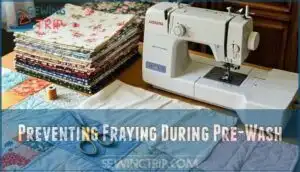This site is supported by our readers. We may earn a commission, at no cost to you, if you purchase through links.

The difference between a quilt that lasts generations and one that falls apart in five years often comes down to three things: how you prep your fabric, how you clean finished projects, and where you store everything in between.
Get these fundamentals right, and your quilts won’t just survive—they’ll become the heirlooms your grandkids fight over.
Table Of Contents
Key Takeaways
- Proper cotton fabric care—prewashing, cold-water washing, and controlled drying—prevents up to 10% shrinkage, 30% fiber weakening, and color bleeding that can permanently damage quilts.
- Strategic fabric storage in breathable containers at 50–60°F with 50% humidity, away from sunlight and plastic bins, protects quilts from fading, mildew, and pest damage for decades.
- Common mistakes like overloading washing machines, excessive ironing, ignoring minor repairs, and washing too frequently accelerate fabric deterioration and shorten quilt lifespan significantly.
- Organized fabric management through color-coding, transparent containers, and scrap sorting transforms chaotic stashes into accessible resources while preserving material quality for future projects.
Why Quilting Cotton Fabric Care Matters
Cotton is a quilter’s best friend, but only if you treat it right. Poor care leads to shrinkage, fading, and frayed edges that can ruin hours of work.
Here’s what proper fabric care protects and why it matters from the start.
Benefits of Proper Fabric Care
Taking care of your quilting cotton isn’t just about keeping fabric clean—it’s about protecting the time, creativity, and heart you pour into every stitch. Proper fabric care delivers real benefits that go beyond appearance:
- Longevity: Cotton quilting fabric maintains its strength and softness through years of use and washing
- Cost Savings: Prewashing and careful management prevent expensive fabric waste from shrinkage or bleeding
- Quality Preservation: Thoughtful fabric care keeps colors vibrant and fibers intact
- Aesthetic Appeal: Well-maintained quilts look crisp and beautiful, showcasing your craftsmanship
- Heirloom Worth: Proper quilt storage and fabric preservation turn your projects into treasured keepsakes for generations
Common Issues From Improper Care
When quilt care goes wrong, the consequences show up fast. Fabric shrinkage can reach 10% if you skip pre-washing, warping your finished quilt. Color bleeding affects 15–30% of multicolored quilts washed improperly, leaving permanent stains. Fabric pilling appears 35% more often in pure cotton after repeated washing, while harsh detergents or bleach can slash fiber strength by 30%. Aggressive scrubbing causes fiber breakage and weak spots.
Improper quilt care causes up to 10% shrinkage, 30% color bleeding, increased pilling, and weakened fibers from harsh detergents
These textile deterioration issues aren’t just cosmetic—they shorten your quilt’s life and undo hours of careful work. A common issue arises from inconsistent seam allowance, which can also lead to uneven quilts.
Shrinkage prevention and proper textile maintenance stop these problems before they start.
Preserving Heirloom Quilts
Antique quilts and family treasures demand a different approach. Heritage preservation starts with proper heirloom storage: keep your quilt flat in darkness at 50–60°F with 50% humidity to prevent fading and fiber stress. Manage it with clean cotton gloves to avoid oil transfer, and check every 3–5 years for early deterioration.
Hand wash only when necessary using gentle detergent, supporting the wet weight carefully during drying. Document repairs and history to maintain textile legacy. These fabric conservation steps guarantee quilt longevity—some family pieces survive over a century with mindful quilt care. By following proper heirloom quilt care techniques, you can help preserve your family’s heritage.
Preparing Cotton Fabric Before Quilting
Before you start cutting and stitching, taking time to prep your cotton fabric can save you from headaches down the road. Pre-washing isn’t always necessary, but knowing when and how to do it makes all the difference.
Here’s what you need to keep in mind before your fabric hits the cutting mat.
Why Pre-Washing is Recommended
Pre-washing your cotton fabric before you cut and sew isn’t just a cautious habit—it’s your insurance policy against a finished quilt that warps, shrinks, or bleeds color the first time it gets washed.
Prewashing addresses fabric shrinkage head-on, removes manufacturing chemicals, and softens the material for easier manipulation.
You’ll catch color bleeding early—especially with bold or dark cotton quilting fabric—and enjoy peace of mind knowing your quilt won’t surprise you later.
When Pre-Washing Isn’t Needed
Not every piece of fabric needs a trip to the washing machine—some cottons are ready to cut the moment you bring them home, and pre-washing can actually do more harm than good.
Skip prewashing for pre-cuts like charm packs and jelly rolls—you’ll unravel those tidy edges. Fabrics with special finishes (think batiks or hand-dyes) lose their character when washed early.
If you’re after vintage looks with that crinkled, heirloom charm, leave the fabric as-is. Chemical-free cotton quilting fabric from trusted sources often needs gentle care without prewashing. Smart fabric sorting means knowing when less is more.
How to Pre-Wash Cotton Fabric
When you’re ready to pre-wash, think of it as giving your cotton a gentle test run before the real work begins. Sort by color first—lights, darks, and brights—to protect color fastness.
Use cold water and a mild detergent on a gentle cycle to minimize fabric shrinkage and soften the fibers.
This pre-treatment method preps your cotton quilting fabric for accurate cutting while preserving its properties through smart fabric care and cotton preparation.
Preventing Fraying During Pre-Wash
Cotton fabric’s raw edges can unravel fast in a washing machine, turning your pre-wash into a tangled mess if you don’t take a few simple precautions. Trim loose threads and clip yardage into manageable pieces—around half a yard works well for cotton stability.
Use pinking shears for edge sealing, or run a quick zigzag stitch along raw edges before prewashing. This fray prevention keeps your cotton quilting fabric intact during gentle washing, ensuring proper fabric management and fabric care from start to finish.
Washing and Drying Quilted Cotton Projects
Once your quilt is finished, knowing how to wash and dry it properly keeps it looking fresh without causing damage. The right techniques protect your hard work from shrinkage, fading, and wear.
Here’s what you need to know to care for your quilted cotton projects safely.
Choosing The Right Detergent
The detergent you choose can make or break your quilt’s longevity, so it’s worth being picky about what goes into your wash. Look for a gentle detergent that’s phosphate free—harsh chemicals can weaken fibers and fade colors over time.
Check washing instructions on the label to verify it’s safe for fabric care and color preservation. A mild formula helps prevent mildew while protecting your quilt’s delicate weaving without stripping its vibrancy.
Best Washing Methods for Quilts
Your cotton quilt deserves a gentle touch—think of washing it like bathing a baby rather than scrubbing a floor. Cold water and a delicate or hand-wash cycle protect fibers from stress, while color catcher sheets safeguard against dye bleeding.
- Use gentle washing cycle settings with minimal agitation and spin speeds
- Keep water temperature at or below 30°C (85°F) to prevent shrinkage
- Add a color catcher sheet to protect your cotton quilt from color transfer
- Skip soak cycles if your quilt has bold colors prone to bleeding
Hand washing offers the most control for heirloom pieces.
Stain Removal and Pretreating Tips
Spot a spill on your quilt and your heart sinks—but catching stains early and treating them right can save you from heartbreak later. Stain identification matters—grease, wine, and mud each need different approaches.
Pre-treat methods like dabbing (never rubbing) with mild soap work wonders for spot cleaning. Test any solution on a hidden seam first for fabric protection and color preservation. Follow care instructions closely, and you’ll master stain prevention through quick action.
Proper Drying Techniques
Once you’ve tackled the stain, how you dry your quilt can make or break all that careful cleaning work. Air drying flat on a clean sheet is your safest bet for quilting cotton—it protects the batting and prevents seam stress. Reshape wet quilts gently before drying to maintain their form.
5 Essential Quilt Drying Methods:
- Flat drying on towels or sheets prevents distortion and weight strain
- Tumble dry on low heat only if you’re short on time
- Airdrying outdoors in shade avoids sun fading
- Never wring or hang wet quilts—seams can’t manage the stress
- Gentle dry with minimal heat preserves fiber integrity and color
Storing Cotton Fabric and Finished Quilts
You’ve done the hard work of washing and drying your cotton fabric and quilts—now it’s time to keep them in great shape for the long haul.
How you store your materials makes all the difference in preventing fading, mildew, and damage from pests. Let’s walk through the best ways to protect your cotton so it stays fresh and ready for your next project.
Ideal Storage Conditions
To keep your cotton safe for years to come, focus on temperature control and humidity levels. Store fabric and quilts in spaces that hover between 18°C and 21°C, and keep humidity below 50%—anything above 65% invites mold and weakens fibers.
Choose polypropylene containers (marked with recycling symbol ‘5’) or breathable cotton bins for proper fabric storage. Skip cardboard boxes and avoid direct contact with unsealed wood, as both can release acids that stain.
For pest prevention, tuck lavender sachets or cedar pieces nearby, and always store in dark areas to prevent UV fading. These quilt storage methods protect your work from environmental damage.
Folding Vs. Rolling Fabric
How you choose to arrange your fabric—whether folded neatly or rolled loosely—can mean the difference between fresh yardage and stubborn creases that refuse to iron out. For quilting projects, folding boards keep cotton quilting fabric tidy and prevent fabric creasing.
Rolling techniques work best for larger yardage, reducing stress on fibers. Both fabric storage methods protect your stash when paired with proper quilt storage solutions and careful fabric management.
Natural Pest Deterrents (Lavender, Cedar)
Tucking lavender sachets or cedar blocks between your folded quilting cotton won’t just make your storage space smell nice—they’ll quietly guard against moths and fabric-munching pests without exposing your fabric to harsh chemicals.
These natural repellents offer gentle pest control for fabric storage:
- Lavender sachets keep insects away while adding a pleasant scent to your quilt storage methods
- Cedar chips naturally repel moths and other fabric-damaging bugs
- Herbal deterrents refresh fabric care routines without chemical residue
Replace them every few months to maintain protection.
Avoiding Sunlight and Plastic Bins
Leaving your cotton fabric stash in a sunny spot or stuffed into plastic bins is like inviting trouble to set up camp—UV rays will fade those vibrant prints faster than you’d think, while trapped moisture inside plastic creates the perfect breeding ground for mildew and musty odors.
| Storage Risk | What Happens | Better Alternative |
|---|---|---|
| Direct sunlight | UV protection fails; colors fade permanently | Store in dark closets or covered shelves |
| Plastic bins | Moisture traps cause mildew growth | Use breathable containers like cotton bins |
| Poor ventilation | Musty smells develop in fabric storage | Choose muslin bags or fabric-lined boxes |
| Heat exposure | Fibers weaken; quilt care and maintenance suffers | Keep cotton quilting fabric in cool spaces |
Caring for cotton fabrics means protecting them from environmental damage with gentle management and quilt storage and maintenance practices that allow airflow—think fabric storage solutions that breathe, paired with natural deterrents for complete protection.
Organizing Quilting Cotton for Easy Access
When you’ve got a growing fabric stash, a little organization goes a long way. The right system helps you find what you need without digging through piles or forgetting what you already own.
Here are three practical ways to keep your quilting cotton tidy and within reach.
Sorting by Color, Type, or Theme
If your fabric stash feels like a chaotic jumble, sorting it by color, type, or theme can transform it into a source of instant inspiration. Color coding your cotton quilting fabric lets you spot the perfect shade fast, while fabric typing—grouping by weight or print style—streamlines quilting fabric preparation.
Theme sorting works wonders for seasonal projects, turning fabric management into a creative jumpstart rather than a scavenger hunt.
Using Transparent Containers and Labels
Clear containers and labels turn fabric browsing into a quick visual scan instead of a guessing game with mystery bundles. Transparent storage solutions let you see exactly what you’ve got without unpacking everything. Label each container by yardage, color family, or project type—whatever suits your workflow.
You’ll spend less time hunting and more time stitching. Smart organization tips like these make fabric storage and preservation seamless, keeping your quilting cotton visible and protected. That’s fabric care and storage done right.
Storage Solutions for Fabric Scraps
Scraps pile up fast, and without a system, they become a jumbled mess that’s more frustrating than useful. Try these fabric storage and organization tactics:
- Sort scraps by size into fabric bins—small, medium, and large cuts stay separated and ready.
- Use labeled fabric boxes for color families, making scrap sorting seamless during fabric management.
- Keep folded storage on cotton shelves to prevent creasing and simplify fabric maintenance.
Smart fabric storage and preservation keeps your workspace functional.
Mistakes to Avoid in Cotton Fabric Care
Even small missteps in fabric care can lead to big problems down the road. You don’t want to accidentally ruin your favorite cotton or waste time fixing avoidable damage.
Here are the most common mistakes quilters make—and how to steer clear of them.
Overloading The Washing Machine
Cramming too many quilts into one load is like stuffing a suitcase until the zipper groans—something’s bound to give. Overloading your washing machine restricts water flow and prevents proper agitation, leaving detergent trapped in fibers.
Your quilts won’t get clean, and the extra bulk can stress seams or cause fabric damage. Stick to the machine capacity guidelines—usually one or two quilts per cycle—to protect your work and get better washing results.
Excessive Ironing or Steaming
Press too hard with a hot iron, and you might scorch fabric or melt batting—heat damage doesn’t fade with time, it gets worse. Steam settings can distort quilting cotton or warp piecing.
Use moderate heat and proper pressing techniques instead—lift and place the iron rather than dragging it.
Light, controlled ironing prevents fabric scorching and keeps your fabric care routine safe without sacrificing effective wrinkle removal.
Ignoring Repairs and Maintenance
A small split seam or loose thread might not look like much now, but left alone, it can unravel into a much bigger problem down the road. Regular damage assessment helps you catch fabric degradation early, before minor issues require extensive repair techniques. Set simple maintenance schedules to inspect your quilts and avoid the neglect consequences that shorten their lifespan.
Quilt maintenance tips to prevent damage:
- Check seams and bindings every few months for wear
- Reinforce weak spots with matching thread before they tear
- Follow quilt repair advice and fabric care guidelines to address problems promptly
Washing Too Frequently
Just as important as fixing damage is knowing when to leave your quilt alone—overwashing wears down fibers faster than regular use ever could. Each trip through the washing machine accelerates fabric wear and color fading, even with gentle cycling and mild detergent.
Unless you’re dealing with visible stain removal needs, skip unnecessary washes to control shrinkage and prevent fiber damage that shortens your quilt’s life.
Frequently Asked Questions (FAQs)
Can I use fabric softener on quilting cotton?
Skip fabric softener on your cotton quilting fabric. Softeners coat fibers, reducing absorbency and interfering with batting adhesion.
Instead, try gentler laundry tips like vinegar rinses or specialized quilting detergents that preserve fabric integrity without causing cotton shrinkage.
How do you test fabric for colorfastness?
Wondering if your fabric will run in the wash? Dampen a fabric swatch with cold water, then press it against white cloth. If dye transfers, pretreat stains with quilt soap and use a color catcher sheet during washing to prevent color bleed and fading.
What thread count is best for quilting cotton?
Thread count isn’t usually specified for quilting cotton—instead, focus on thread weight and fabric density.
Quality quilting cotton features a tight, balanced weave with consistent stitch count and strong yarn quality, ensuring durability and ease of manipulation during quilting techniques.
Should I trim selvage edges before storing fabric?
You’ll want to trim those selvage edges before storing—they’re tighter and can warp your cotton quilting fabric over time.
It’s one of those fabric storage tips that prevents headaches later. Edge finishing methods don’t need to be fancy; just snip them off.
How long does quilting cotton last in storage?
Properly stored quilting cotton fabric can last decades—even 50 years or more—when kept in cool, dry, dark conditions.
Fabric shelf life depends on storage conditions; poor cotton degradation happens with heat, moisture, or light exposure, threatening fiber longevity and archive preservation of your cotton quilt collection.
Conclusion
Years from now, someone will pull your quilt from storage and marvel at the vibrant colors, intact seams, and soft texture—or they’ll wonder why it yellowed, shrunk, and fell apart.
Quilting cotton fabric care isn’t about obsessive excellence; it’s about simple habits that compound over time. Wash gently, store thoughtfully, and organize intentionally.
The quilts you stitch today will outlive you if you treat them like the treasures they already are.
- https://www.cottoninc.com/wp-content/uploads/2017/12/ISP-1009-Guide-to-Improved-Shrinkage-Performance-of-Cotton-Fabrics.pdf
- https://californiaagriculture.org/api/v1/articles/111747-laundering-methods-affect-fabric-wear.pdf
- https://graceframe.com/en/resources/blog/10-most-common-mistakes-when-quilting-and-how-to-avoid-them
- https://sayaindustries.com/unraveling-textile-failures-understanding-the-reasons-behind-fabric-challenges/
- https://www.sciencedirect.com/science/article/pii/S0959652622010186














